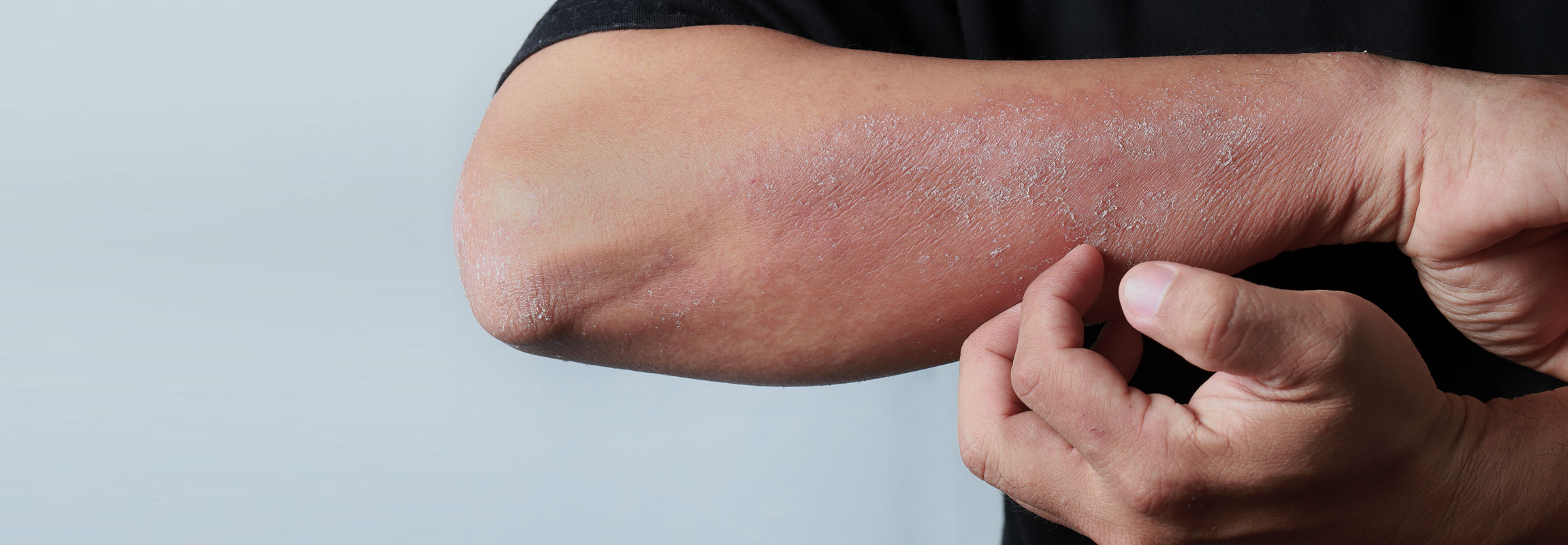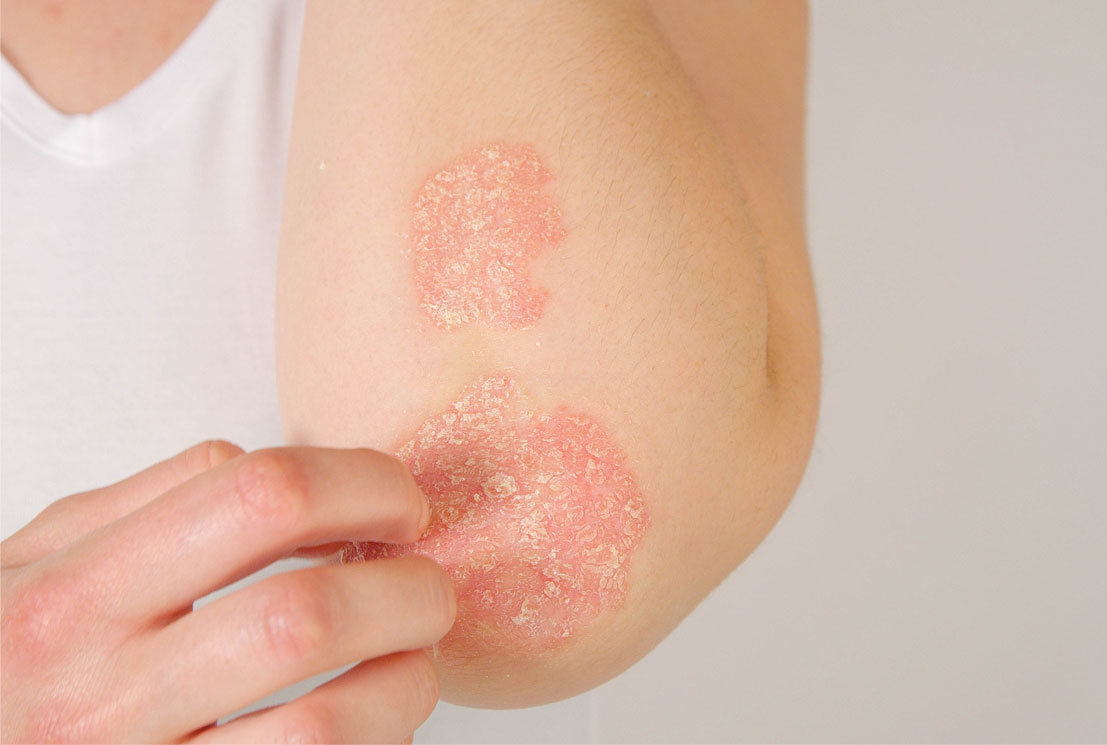
A common skin condition, psoriasis occurs when an overactive immune system causes inflammation (redness and swelling) of the skin and speeds up normal skin cell growth.
Usually when skin cells regenerate, they shed away naturally and gradually, and new skin cells come to the surface. Yet with psoriasis, the body accelerates the life cycle of skin cells by up to 10 times. Skin cells pile up on the skin surface, causing thick, hardened scaly patches which may be itchy.

How Common is Psoriasis?
According to the National Skin Centre, psoriasis is estimated to affect 1-2% of the population in Singapore.
It is also a very common skin disorder among millions of people worldwide.
Though the most usual age of onset is the 20s to 30s and the 50s to 60s, psoriasis affects all races, sexes, adults and children alike.
Did You Know?
Plaques can appear as a few small patches or affect large areas of the body.
It’s possible to have psoriasis plaques and scales in more than one location on the body at a time.
It’s possible to have more than one type of psoriasis at one time and – more than one type in a lifetime.
Psoriatic differs from many other skin conditions in that the inflammation, caused by an overactive immune system, is not limited to skin alone.
Up to 40% of psoriasis sufferers may also develop psoriatic arthritis: inflammation of joints or ligaments around the joints, resulting in arthritic aches and pains, joint swelling with progressive joint destruction, and deformities if left untreated.
The risk of having psoriatic arthritis is higher for those with nail psoriasis, more severe psoriasis, or a family history of psoriatic arthritis.
What Causes Psoriasis?
The abnormal rapid growth of skin cells is triggered by a multitude of factors, with genetics and the immune system playing key roles.
Genetic
While psoriasis can affect people without a family history of the condition, having a family member with psoriasis increases your risk by:
- a 10% chance for those with one affected parent
- a 40% chance for those with two affected parents.
The Immune System
A triggering event may cause the immune system to over-react, resulting in the onset of psoriasis symptoms.
Common triggers include:
- Stress
- Injury to the skin e.g. cuts and bruises
- Infections e.g. bronchitis
- Cold, dry climate
- Smoking
- Alcohol
Stress is one of the most common psoriasis triggers. At the same time, psoriasis flare-ups can cause you further stress. To break the endless cycle, seek customised treatment.
Call us at 6733 3629 to schedule your consultation.
What are the Different Forms of Psoriasis?
Psoriasis usually appears on the scalp, elbows, knees, lower back and genitals, though it can appear anywhere on the body, including the fingernails.
General symptoms can vary from small areas of mild rash to severe inflamed plaques (raised patches—usually salmon pink or red in colour—with scaly, flaky dead skin that can be itchy).
Plaque Psoriasis:

The most common form of psoriasis, plaques may appear symmetrically on both left and right sides of the body, typically on elbows, knees, extensor surface of arms/legs, and lower back.
Scalp Psoriasis:

Fine scaling that looks like mere dandruff, or thick, crusted plaques that cover the entire scalp; begins as persistent dandruff in the scalp before spreading to the forehead, and back of neck and ears.
Palmoplantar Psoriasis:

Red, dry and thickened skin on palms and/or soles, which may crack and cause pain; often mistaken for hand and feet eczema.
Guttate Psoriasis:

Where there are small, raindrop-like spots on the skin, often widespread on the arms, legs and torso, and could even appear on face, ears and scalp; commonly seen in children and young adults.
Flexural Psoriasis:

Affects skin folds in the groin, underarms and under the breasts with well-demarcated, red, smooth and shiny areas.
Pustular Psoriasis:

Small pus-filled blisters with surrounding redness and swelling of the skin; may be localised to the palms or soles.
Erythrodermic Psoriasis:

Generalised red, swollen, scaly skin; though a rarer form of psoriasis, it can be life-threatening, with severe itching and pain, changes in heart rate, dehydration, heat loss, protein loss, abnormal electrolytes, and even heart failure.
Nail Psoriasis:

Wide range and severity of nail changes, from discoloration, pitting, separation of the nail from the nail bed, to very thickened and deformed nails. Associated with higher risk of psoriatic arthritis.
Psoriatic Arthritis:

Psoriasis inflammation may affect any one or multiple joints, or the soft tissue around the joints such as ligaments and tendons. They may present as pain and stiffness in joints on waking, swollen painful joints, or sausage-like swelling of fingers or toes. Often mistaken for gout, involvement of the skin provides a good clue to diagnosis. If left untreated, psoriatic arthritis is progressive and causes joint destruction and deformities. Early treatment, especially with biologics, not only limits pain but also prevents joint destruction.
“Just as no two patients are alike, psoriasis treatments aren’t one-size-fits-all: it takes a dermatologist well informed in psoriasis medical science to customise your effective treatment plan.”
Dr Wong Su-Ni
Consultant Dermatologist
Listening actively to your concerns, Dr Wong will work closely with you to ascertain the triggers of your psoriasis condition. We believe that regaining your skin’s health and comfort is key to your personal well-being.
Call us at 6733 3629 or drop us a message here.

Dr SN Wong Skin, Hair, Nails & Laser Specialist Clinic
3 Mt Elizabeth #07-09, Mt Elizabeth Medical Centre, Singapore 228510
Tel : (65) 6733 3629 | Fax : (65) 6733 3628
Email: [email protected]
